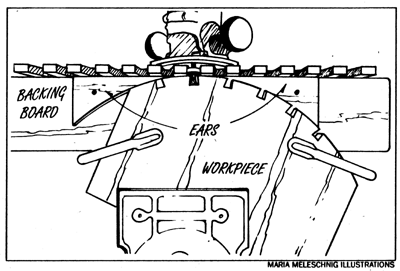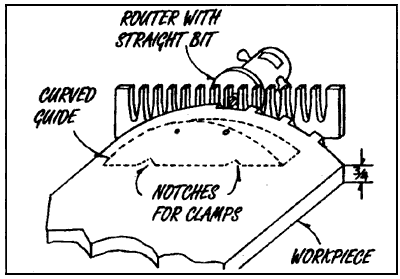| Woodshop News (www.woodshopnews.com) detailed the Keller Dovetail System's ability to cut curved dovetails. This review is © 1992 Woodshop News.
By Marge McCormick
Staff Writer, Woodshop News
David Keller, inventor of a popular dovetail jig, has devised a way to use his jig for cutting dovetails on curved sections.
The idea came up, Keller said, when someone suggested he make a barrel top chest with dovetailed lid.
"I've made angled dovetails, compound angles, acute angles, obtuse angles," Keller said from his business, Keller & Co., in Petaluma, Calif.
But he'd never made dovetails on a radius, so the challenge interested him.
The Keller Dovetail System consists of two 1/2"-thick aluminum alloy templates and two matching router bits, one a straight cutter, and one a dovetail cutter. One of the aluminum templates has angled fingers – for cutting the pins – and one has straight fingers – for cutting the tails.
The router bits have ball bearing mounted above the cutters, a configuration that eliminates the need for guide bushings in the router base.

Keller uses this setup to rout dovetail sockets on a radius, such as the semi-circular ends of a barrel-top chest. The workpiece is clamped to a backing board, and held in position between After cutting the first socket, Keller unclamps the workpiece, rotates it slightly, resets the clamps and cuts the next socket. For safety, it's best to orient the work so the operator stands behind the workpiece, so the chips fly away from him or her.
Mounting holes in the templates allow the user to screw each template to a backing board. The board makes it easy to clamp the stock to the template. It also prevents tear-out as the bit passes through the workpiece.
The system makes through-dovetails with virtually "no measuring, no off-sets, no test cuts, no messing around," Keller said.
The main reason for this simplicity is that the fingers on the pin template exactly align with the scribed plate exactly align with the scribed imprints of the dovetail sockets. There is no offset to allow for because the ball-bearing guide on the straight bit is exactly the same diameter as the bit itself. Thus, said Keller, "What you see is what you get" when you cut the pins.
So after letting the idea of curved dovetails "rattle around" for a while, Keller decided the thing to do was modify the standard backing blocks to accept curved workpieces instead of the usual straight ones.

To cut the pins in the curved barrel-top lid, Keller uses a curved backing board and the template with angled fingers. The sockets can be traces directly onto the barrel top from the tails. This step uses the straight cutter.
The workpiece would have to be unclamped and rotated manually after each cut, but that cut could then be used to index the next one.
The pins would have to be cut in the staved, rounded barrel top, while the tails would be cut in the semi-circular ends. He begins, therefore, with the ends, which are flat.
First, he marks the center and length of the radius so that he can space the dovetails evenly along it, though he adds that the dovetails can be randomly spaced.
Next, using scrap wood, he cuts two curved "ears" the same radius as the lid and screws them to the backing board of the dovetail template.
The ears form an arc into which the workpiece exactly nests.
Then, using the pre-determined distance between dovetails, he set the position for his indexing pin, a dovetail-shaped "key."
He makes the first cut at the center of the radius, unclamps and workpiece, turns it sets the index, reclamps, makes the next cut and so on, until half the dovetails are cut. Then he returns to center and works down the other side.
After repeating this process on the other lid end, Keller prepares to cut the corresponding pins in both ends of the rounded barrel top.
First, he removed the flat backing board from the pin template and replaces it with a curved backing block.
He uses very thick stock, a piece of scrap 4x6, so he has good clamp purchase.
Then, using the end pieces as a pattern, he scribes the location of the dovetail sockets on the ends of the barrel top, just as if he were going to cut the pins by hand.
Then he lays the barrel top over the curved backing block, clamps it in place (he had to notch the 4x6 in order to hold the clamps) and repeats the process of cutting, turning, reclamping and cutting again.
Keller said he had planned to follow the scribe marks, but after one or two cuts he decided to make another indexing mechanism, this time by tacking a pair of stops on either side of a cut pin.
Keller said his curved dovetail jig could open up unlimited possibilities to designers and architects as well as craftsmen.
"They can use staved solid wood, curved plywood, even solid surface materials like Corian. They can dovetail anything – demilune tables, countertops, columns, curved wall sections, specialty boxes – with a surprising amount of efficiency and effectiveness."
The Keller jig is sold in three sizes, 16", 24" and 36" [see Models].
Contact Keller & Co., 1327 I Street, Petaluma, CA 94952. Tel: 707-763-9336. [see Contact Keller & Co.].
|



